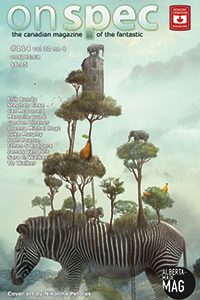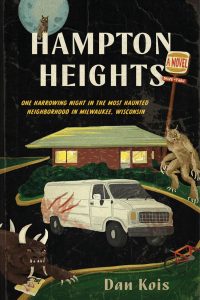Gary K. Wolfe Reviews The Best of Elizabeth Hand by Elizabeth Hand
 The Best of Elizabeth Hand, Elizabeth Hand (Subterranean 978-1-64524-005-1, $45.00, 560pp, hc) February 2021.
The Best of Elizabeth Hand, Elizabeth Hand (Subterranean 978-1-64524-005-1, $45.00, 560pp, hc) February 2021.
I’ve always distrusted the notion of “comfort reading,” especially as it applies to our little corner of the swamp. After all, the very idea of horror fiction involves discomfort, and SF characteristically challenges our sense of the stability of everything from nations to our bodies to the planet itself. I suppose fantasy does leave room for endless retellings of familiar tales with familiar heroes, but the most memorable fantasies are those which subvert and question that very familiarity, like Lavie Tidhar’s recent deconstruction of Arthuriana in By Force Alone. But there’s another sort of comfort reading that has less to do with the tales than with the tellers, and no better examples can be found than two important new retrospective collections, The Best of Elizabeth Hand and The Neil Gaiman Reader. Here the comfort doesn’t derive from the content of the fiction – there are decidedly unsettling and even brutal moments in the work of both writers – but from its execution. It’s the simple comfort of knowing you’re in supremely competent hands, and it’s the sort of comfort I found myself feeling before opening either book, or even glancing at the table of contents (since I’ve reviewed both authors fairly frequently). There is, of course, some curiosity as to whether familiar tales will hold up on a return visit (although the notion of stories “holding up” is another unexamined reading cliché, as though stories were like the brakes on your car), and whether the unfamiliar ones would live up to expectations. In both volumes, while a few stories seemed decidedly minor in compared to others, I’m happy to report that my initial sense of assurance was not misplaced: I found myself re-reading stories I hadn’t expected to re-read, simply because they drew me in all over again. Hand dedicates her collection to John Clute, “Who stirred the Cauldron of Story,” and while no one can dispute that Clute has made a distinguished career of stirring things up, that Cauldron is where Hand and Gaiman work their magic.
Elizabeth Hand’s career has been impressively eclectic. Her first novels, the Winterlong trilogy, were SF in the far-future, dying-Earth tradition of Vance or Wolfe, but she quickly established a reputation in contemporary mythic fantasy with Waking the Moon in 1994 and her first story collection Last Summer at Mars Hill in 1997 – though briefly returning to near-future SF with the millennial novel Glimmering in 1997. With Mortal Love(2004), she moved at least partly into historical fiction, something she returned to in Radiant Days (2012) and Curious Toys, her haunting 2019 novel about outsider artist Henry Darger. Curious Toys was also in part a murder mystery, which reflects another genre shift, already underway with the successful series of Cass Neary crime novels that began with Generation Loss in 2007 and reached its fourth volume with last year’s The Book of Lamps and Banners. This doesn’t even touch upon her various movie novelizations or a DC comic series she created with Paul Witcover.
Despite this variety of genres and modes, Hand’s fiction is distinctively recognizable in a number of ways. Familiar settings include rural or coastal Maine, upstate New York (particularly a town she calls Kamensic Village), the DC area, London (especially Camden Town), and rural areas of southern and western England. Her fascination with outsider or transgressive artists ranges from the mad Victorian Richard Dadd to Darger, Rimbaud to the Ramones, Warhol’s Factory, oddball (or even predatory) children’s writers, actors, tattooists, model-makers, and tragic nutball inventors. Her tone can shift from the elegiac to the furious, her characters from the mournful to the vengeful (but almost never without compassion), her voice from that of a Romantic lyric poet to that of a small-town cosmetics saleswoman gossiping with a customer. That last is from a very early story called “The Have-Nots”, in which the saleswoman relates the how her waitress friend Loretta, after serving “the Colonel” and an unnamed Elvis in her diner, was given the singer’s Cadillac as a tip. In outline, it’s an urban legend, but a subplot involving a long-lost baby daughter and a magical realist ending give it an unexpected poignance. An equally down-home vernacular characterizes “Ghost Light”, a minor but efficient revenge tale narrated by a nightclub light-and-sound technician.
While these vernacular tales demonstrate the tonal range already apparent in Hand’s novels, they’re also the least characteristic stories here. The first few stories in the collection fall into pairs almost neatly. The World Fantasy-winning “Last Summer at Mars Hill” takes place in a fading spiritualist community in Maine that almost literally has fairies at the bottom of the garden. These evanescent “Light Children,” who can’t be seen by everyone, seem to illuminate not only the faith of the aging residents, but the loopy family histories of the central characters, Jason and Moony, who return there for annual family gatherings; Moony had been christened Shadowmoon Starlight Rising by her hippie mom, while Jason’s dad has changed his name to Martin Dionysus. When they learn that Moony’s mom suffers from advanced breast cancer and has decided against treatment, they also find that Mars Hill may hold further surprises. In “Pavane for a Prince of the Air”, the most purely elegiac piece here, another circle of friends, while trying to hold on to their youthful infatuations with fantasy and magic, are faced with the fatal cancer of one of their number; it’s narrated by a writer who sounds a lot like Hand herself (and Hand tells us in a note that it’s closely autobiographical).
These two sweetly melancholy stories are followed by the two most disturbing and uncompromising selections in the book. “The Bacchae” may not seem as transgressive as it must have seemed in 1991, when (Hand tells us) it was voted “the most hated story of the year” in Interzone, but it’s depiction of women turning suddenly violent in a manner that reflects Euripides’s eponymous play is pretty brutal, and the suggestion of a science-fictional connection to environmental collapse (solar shields have been placed in orbit to protect against UV radiation) gives it an even more timely feel. Similarly, the PTSD subtheme of “Cleopatra Brimstone” seems somehow fresher than when the story appeared nearly 20 years ago. Jane, a promising entomology student fascinated since childhood with butterflies and moths, moves to London in the aftermath of a rape that has upended her life. There she volunteers at the Regents Park Zoo while haunting the nightlife around Camden under the name Cleopatra Brimstone (taken from a moth species) and wreaking a unique sort of metamorphosis on the men who try to seduce her. Perhaps more than any other single story, this may have gained Hand a reputation in horror, which is reflected later in the volume by “Near Zennor”, a haunted-landscape tale involving a famous children’s author later found to be a pedophile, but neatly framed in a tale of a widower tracing an incident from his wife’s childhood.
These stories in turn are followed by the two vernacular tales I’ve already mentioned, “Ghost Light” and “The Have-Nots”, and then by the World Fantasy winning novella “The Maiden Flight of McCauley’s Bellerophon“, certainly one of the highlights of the collection and probably the masterpiece of crypto-aviation fiction (although I’m not sure there’s any competition). Crypto-aviation is one of those odd, dusty corners of cultural history having to do with early efforts at heavier-than-air flight. A display-maker at the Smithsonian’s aerospace museum, whose specialty is making models based on wacky old ideas from the museum’s “nut files,” learns that the retired curator who had hired him is dying of cancer. He enlists a couple of friends in a scheme to use his modeling skills to fake evidence of one of her pet theories – that an eccentric inventor named McCauley had actually flown a strange aircraft briefly in 1901, prior to the Wright Brothers, and that the flight had been captured on a now-lost film. While there’s only a hint of material fantasy, it’s a haunting paean to lost, failed, or forgotten dreams.
The next stories that seem to form a group are distinctly apocalyptic in tone. “Fire”, with its group of characters trapped in a research station by one of those raging western wildfires, already seems far less speculative than when it appeared in 2017, though there are hints of a broader disaster – terrorists with drones, an ominous reference to the “LA megafire last year,” lights in the sky that turn out to be entire flocks of birds on fire. “The Last Domain – Three Story Variations” consists of “Echo”, in which a writer living on an isolated island off the coast of Maine writes to a former lover, describing the fragments of news she’s able to get regarding the growing devastation of the outside world; “The Saffron Gatherers”, concerning another writer – this time of apocalyptic novels – who witnesses an actual apocalypse as her plane takes off from San Francisco; and “Kronia”, which in non-linear fragments describes a relationship that unfolds before and after the 9/11 attacks. All three tales are rather elegantly woven around aspects of ancient Greek history and mythology, including, in the case of “The Saffron Gatherers”, the volcanic catastrophe of Santorini. Oddly, though, another story, “Calypso in Berlin”, which had previously been collected as part of this sequence, is missing from the current volume.
The last two stories, “The Least Trumps” and “Illyria”, also seem to form something of a pair, less obviously in terms of subject matter, although both have to do with the weight of family histories, and both offer hints of immanent worlds and lifted veils (a common Hand theme). In “The Least Trumps” (a term familiar to readers of John Crowley’s Little, Big), the emotionally damaged daughter of a famous children’s book writer sets herself up as a tattoo artist in her mother’s remote island cottage in Maine. At a rummage sale she comes across a strange deck of mostly blank Tarot cards which might have belonged to another famous author whose young-adult novels guided the narrator through her adolescence, and whose final unfinished novel had made cryptic references to “the least trumps.” The final, longest, and most perfect novella is “Illyria”, whose narrator Maddy has grown up in a Hudson River valley mansion surrounded by artifacts of her great-grandmother namesake, a legendary actress who claimed theatrical lineage back to Shakespeare’s time. Maddy has been nearly inseparable from her cousin Rogan, with whom she eventually falls in love, setting up the very theatrical crisis that is the story’s central event. In a school production of Twelfth Night (the DNA of which runs like a bright thread through the narrative), Rogan turns out to be a brilliant singer and Maddie at least a skilled actor. The fragility of their artistic dreams come to be embodied in a magical model theatre they discover hidden behind a wall in that rambling mansion (walls are another common image in Hand’s work, and they’re always meant to be breached). Veteran Hand readers might reasonably wonder why some of their own favorite stories have been displaced by some of these longer novellas (and I’ll refrain from mentioning a couple of my own), but it’s hard to argue with an elegant masterpiece like this, or with the balanced overview of Hand’s varied talents that the always-reliable editor Bill Sheehan has assembled here.
Gary K. Wolfe is Emeritus Professor of Humanities at Roosevelt University and a reviewer for Locus magazine since 1991. His reviews have been collected in Soundings (BSFA Award 2006; Hugo nominee), Bearings (Hugo nominee 2011), and Sightings (2011), and his Evaporating Genres: Essays on Fantastic Literature (Wesleyan) received the Locus Award in 2012. Earlier books include The Known and the Unknown: The Iconography of Science Fiction (Eaton Award, 1981), Harlan Ellison: The Edge of Forever (with Ellen Weil, 2002), and David Lindsay (1982). For the Library of America, he edited American Science Fiction: Nine Classic Novels of the 1950s in 2012, with a similar set for the 1960s forthcoming. He has received the Pilgrim Award from the Science Fiction Research Association, the Distinguished Scholarship Award from the International Association for the Fantastic in the Arts, and a Special World Fantasy Award for criticism. His 24-lecture series How Great Science Fiction Works appeared from The Great Courses in 2016. He has received six Hugo nominations, two for his reviews collections and four for The Coode Street Podcast, which he has co-hosted with Jonathan Strahan for more than 300 episodes. He lives in Chicago.
This review and more like it in the February 2021 issue of Locus.
 While you are here, please take a moment to support Locus with a one-time or recurring donation. We rely on reader donations to keep the magazine and site going, and would like to keep the site paywall free, but WE NEED YOUR FINANCIAL SUPPORT to continue quality coverage of the science fiction and fantasy field.
While you are here, please take a moment to support Locus with a one-time or recurring donation. We rely on reader donations to keep the magazine and site going, and would like to keep the site paywall free, but WE NEED YOUR FINANCIAL SUPPORT to continue quality coverage of the science fiction and fantasy field.
©Locus Magazine. Copyrighted material may not be republished without permission of LSFF.







